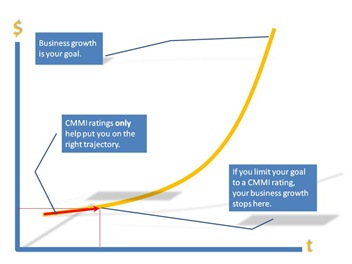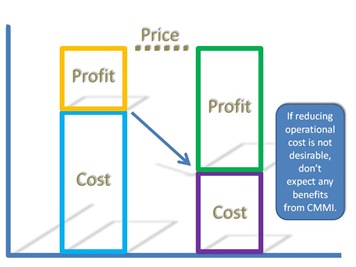There’s an under-appreciated reality of what either agile or CMMI can accomplish for an organization. In particular, it’s not as much about what either accomplishes for an organization as much as it is about what an organization does for itself that achieves agility and systemic improvement.
It seems to be a decades-old issue that many technology-oriented companies, and, it seems, especially software companies, struggle with organizing and managing operations towards excellence. I can’t even begin to dig into any reasons why this is so, but there may be some truth to the stereotype about technology people not being good with business and/or people. ![]()
I’ve found something fascinating that is fairly consistent across many companies I’ve visited or discussed with colleagues. What’s fascinating about it is not only the consistency across multiple fields, industries, verticals, and national boundaries, but that it reinforces a position I’ve taken since beginning my career. That position is the afore-mentioned “under-appreciated reality”:
Aligning the organization with specific business goals and providing a supportive culture
leads to broad behaviors at all levels that result in high performance.
OK. So, that may not seem earth-shattering. But there’s a lot in this statement about agile and CMMI that too many organizations to “get”. And, this is where all the anecdotal evidence from the many companies comes into play:
Organizations with a culture of excellence generate behaviors (including setting and pursuing specific business goals) that achieve agility and systemic improvement without specifically setting out to achieve either “agile” or “CMMI”.
Throughout my earlier career, I was routinely frustrated by “training” that provided me with specific tools and techniques for dealing with “many common” situations – pretty much all of which were cultural, interpersonal, and otherwise based on human behavior. The cases, examples, and solutions all felt very canned and contrived. Why? Because, in effect, they were. They were very specific to the context and would only solve issues in that context. What the examples lacked – and by extension, the entire course – was fundamental tools with which to deal with situations that were not neatly boxed into the provided context. In other words, these training courses provided practices. These practices work in explicit situations, but they fail to provide the basis upon which those practices were built. Without such a basis, I and other consumers of this “training” could not address real situations that didn’t match the training’s canned scenarios.
“Doing” agile or CMMI by “doing” their respective practices results in exactly the same limited benefits.
Making agile or CMMI “about agile” or “about CMMI” accomplishes little value and lots of frustration. These are only practices. Practices are devoid of context. A culture of excellence and an explicit business case to pursue improvements provide the necessary context.
We see this all the time. For example, for decades in the West mathematics was taught in a way left many students wondering, “what will I do with this?” (This may still be true in many places.) It was/is taught without any context to how it can help them better analyze and understand their world. As a result, Western students have historically been less interested in math, do less well in math tests, and are less inclined to study in fields heavily dependent on math. All due to being taught math for math’s sake and not as a means to a beneficial end.
Medicine is also taught this way around the world. Leading too many doctors to seeing patients as packages “symptoms” and “illnesses” rather than as people who need help. Scientific exploration often gets caught up in the same quandary. Exploration is the goal, if you’re looking for a specific answer, it’s research. When you’re trying to create a specific solution it’s development. Mixing-up “exploration” with R&D will frequently result in missing interesting findings in pursuit of narrow objectives.
In agile practices, what’s more important: doing Scrum or delivering value? Pair programming, or reducing defects? Maximizing code coverage in unit tests or testing the right parts of the product? “Doing” Scrum, pairing, and automating unit tests are intended to deliver more product of high value, sooner. Focusing on the practices and not what’s best for the customer are missing the point of these practices. Same with CMMI.
What are the economics of your core operation? Not just what your group costs to operate on a monthly basis, but what unit of value is produced for any given unit of time? How do you know? Why do you believe your data is reliable? The ability to make decisions relies on data and when the data is unreliable, decisions, plans and anything else that relies on the data is questionable and risky.
It turns out (not surprisingly) that when a group focuses on what’s important AND has the economic data to reliably understand the behavior of their operation, it aligns their actions with the very same goals set-forth in both agile and CMMI.
Focusing on the right things in your operation will cause behaviors that achieve agility and “rate well” against CMMI. Whether or not you’re even trying to “do” agile or CMMI.


 If getting leaner isn’t appealing, stay away from CMMI.
If getting leaner isn’t appealing, stay away from CMMI. On the other hand, what can we consultants and appraisers do when executives willingly take the “ratings over growth” route? When executives are not willing to stand up for what’s best for the business? When the executives are not motivated to pursue operational excellence? At the same time, we’ve all been using the wrong language with CMMI. Who the heck wants to hear about “process improvement”?!? That’s a lot like wanting to hear “you need to go on a diet and get more exercise”. Who wants that?
On the other hand, what can we consultants and appraisers do when executives willingly take the “ratings over growth” route? When executives are not willing to stand up for what’s best for the business? When the executives are not motivated to pursue operational excellence? At the same time, we’ve all been using the wrong language with CMMI. Who the heck wants to hear about “process improvement”?!? That’s a lot like wanting to hear “you need to go on a diet and get more exercise”. Who wants that?


